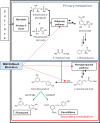Production of highly bioactive resveratrol analogues pterostilbene and piceatannol in metabolically engineered grapevine cell cultures
- PMID: 26947765
- PMCID: PMC5069453
- DOI: 10.1111/pbi.12539
Production of highly bioactive resveratrol analogues pterostilbene and piceatannol in metabolically engineered grapevine cell cultures
Abstract
Grapevine stilbenes, particularly trans-resveratrol, have a demonstrated pharmacological activity. Other natural stilbenes derived from resveratrol such as pterostilbene or piceatannol, display higher oral bioavailability and bioactivity than the parent compound, but are far less abundant in natural sources. Thus, to efficiently obtain these bioactive resveratrol derivatives, there is a need to develop new bioproduction systems. Grapevine cell cultures are able to produce large amounts of easily recoverable extracellular resveratrol when elicited with methylated cyclodextrins and methyl jasmonate. We devised this system as an interesting starting point of a metabolic engineering-based strategy to produce resveratrol derivatives using resveratrol-converting enzymes. Constitutive expression of either Vitis vinifera resveratrol O-methyltransferase (VvROMT) or human cytochrome P450 hydroxylase 1B1 (HsCYP1B1) led to pterostilbene or piceatannol, respectively, after the engineered cell cultures were treated with the aforementioned elicitors. Functionality of both gene products was first assessed in planta by Nicotiana benthamiana agroinfiltration assays, in which tobacco cells transiently expressed stilbene synthase and VvROMT or HsCYP1B1. Grapevine cell cultures transformed with VvROMT produced pterostilbene, which was detected in both intra- and extracellular compartments, at a level of micrograms per litre. Grapevine cell cultures transformed with HsCYP1B1 produced about 20 mg/L culture of piceatannol, displaying a sevenfold increase in relation to wild-type cultures, and reaching an extracellular distribution of up to 45% of total production. The results obtained demonstrate the feasibility of this novel system for the bioproduction of natural and more bioactive resveratrol derivatives and suggest new ways for the improvement of production yields.
Keywords: Vitis vinifera; grapevine cell culture; metabolic engineering; piceatannol; pterostilbene; resveratrol.
© 2016 The Authors. Plant Biotechnology Journal published by Society for Experimental Biology and The Association of Applied Biologists and John Wiley & Sons Ltd.
Figures









Similar articles
-
Rosa hybrida orcinol O-methyl transferase-mediated production of pterostilbene in metabolically engineered grapevine cell cultures.N Biotechnol. 2018 May 25;42:62-70. doi: 10.1016/j.nbt.2018.02.011. N Biotechnol. 2018. PMID: 29477599
-
Bioconversion of stilbenes in genetically engineered root and cell cultures of tobacco.Sci Rep. 2017 Mar 27;7:45331. doi: 10.1038/srep45331. Sci Rep. 2017. PMID: 28345676 Free PMC article.
-
A stress-inducible resveratrol O-methyltransferase involved in the biosynthesis of pterostilbene in grapevine.Plant Physiol. 2008 Nov;148(3):1630-9. doi: 10.1104/pp.108.126003. Epub 2008 Sep 17. Plant Physiol. 2008. PMID: 18799660 Free PMC article.
-
Biosynthesis of resveratrol and piceatannol in engineered microbial strains: achievements and perspectives.Appl Microbiol Biotechnol. 2019 Apr;103(7):2959-2972. doi: 10.1007/s00253-019-09672-8. Epub 2019 Feb 23. Appl Microbiol Biotechnol. 2019. PMID: 30798357 Review.
-
Effects of elicitors, viticultural factors, and enological practices on resveratrol and stilbenes in grapevine and wine.Mini Rev Med Chem. 2012 Nov;12(13):1366-81. doi: 10.2174/13895575112091366. Mini Rev Med Chem. 2012. PMID: 22303949 Review.
Cited by
-
Cereal sprout-based food products: Industrial application, novel extraction, consumer acceptance, antioxidant potential, sensory evaluation, and health perspective.Food Sci Nutr. 2023 Nov 14;12(2):707-721. doi: 10.1002/fsn3.3830. eCollection 2024 Feb. Food Sci Nutr. 2023. PMID: 38370091 Free PMC article. Review.
-
Pterostilbene Attenuates Astrocytic Inflammation and Neuronal Oxidative Injury After Ischemia-Reperfusion by Inhibiting NF-κB Phosphorylation.Front Immunol. 2019 Oct 17;10:2408. doi: 10.3389/fimmu.2019.02408. eCollection 2019. Front Immunol. 2019. PMID: 31681297 Free PMC article.
-
Biosynthesis of Piceatannol from Resveratrol in Grapevine Can Be Mediated by Cresolase-Dependent Ortho-Hydroxylation Activity of Polyphenol Oxidase.Plants (Basel). 2024 Sep 18;13(18):2602. doi: 10.3390/plants13182602. Plants (Basel). 2024. PMID: 39339576 Free PMC article.
-
Factors Affecting the Regeneration, via Organogenesis, and the Selection of Transgenic Calli in the Peach Rootstock Hansen 536 (Prunus persica × Prunus amygdalus) to Express an RNAi Construct against PPV Virus.Plants (Basel). 2019 Jun 17;8(6):178. doi: 10.3390/plants8060178. Plants (Basel). 2019. PMID: 31213013 Free PMC article.
-
New Insights into Dietary Pterostilbene: Sources, Metabolism, and Health Promotion Effects.Molecules. 2022 Sep 25;27(19):6316. doi: 10.3390/molecules27196316. Molecules. 2022. PMID: 36234852 Free PMC article. Review.
References
-
- Aggarwal, B.B. , Bhardwaj, A. , Aggarwal, R.S. , Seeram, N.P. , Shishodia, S. and Takada, Y. (2004) Role of resveratrol in prevention and therapy of cancer: preclinical and clinical studies. Anticancer Res. 24, 2783–2840. - PubMed
-
- Almagro, L. , Belchí‐Navarro, S. , Sabater‐Jara, A.B. , Vera‐Urbina, J.C. , Selles‐Marchart, S. , Bru, R. and Pedreño, M.A. (2013) Bioproduction of trans‐resveratrol from grapevine cell cultures. In Handbook of Natural Products, ( Ramawat, K.G. and Merillon, J.M. , eds), pp. 1683–1713. Heidelberg: Springer.
-
- Asensi, M. , Medina, I. , Ortega, A. , Carretero, J. , Baño, M.C. , Obrador, E. and Estrela, J.M. (2002) Inhibition of cancer growth by resveratrol is related to its low bioavailability. Free Radic. Biol. Med. 33, 387–398. - PubMed
-
- Baur, J.A. and Sinclair, D.A. (2006) Therapeutic potential of resveratrol: the in vivo evidence. Nat. Rev. Drug Discov. 5, 493–506. - PubMed
-
- Bavaresco, L. , Fregoni, M. , Trevisan, M. , Mattivi, F. , Vrhovsek, U. and Falchetti, R. (2002) The occurrence of the stilbene piceatannol in grapes. Vitis, 41, 133–136.
MeSH terms
Substances
Associated data
- Actions
- Actions
- Actions
LinkOut - more resources
Full Text Sources
Other Literature Sources

